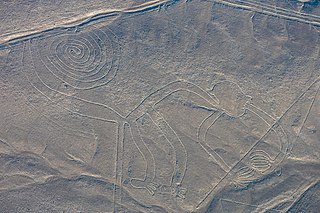
The Nazca Lines are a group of geoglyphs made in the soil of the Nazca Desert in southern Peru. They were created between 500 BCE and 500 CE by people making depressions or shallow incisions in the desert floor, removing pebbles and leaving differently colored dirt exposed. There are two major phases of the Nazca lines, Paracas phase, from 400 to 200 BCE, and Nazca phase, from 200 BCE to 500 CE. In the years leading up to 2020, between 80 and 100 new figures had been found with the use of drones, and archaeologists believe that there are more to be found.

Aztalan State Park is a Wisconsin state park in the Town of Aztalan, Jefferson County. Established in 1952, it was designated a National Historic Landmark in 1964 and added to the National Register of Historic Places in 1966. The park covers 172 acres (70 ha) along the Crawfish River.

Għar Dalam is a 144 metre long phreatic tube and cave, or cul-de-sac, located in the outskirts of Birżebbuġa, Malta. The cave contains the bone remains of animals that were stranded and subsequently became extinct in Malta at the end of the Last Glacial Maximum. It has lent its name to the Għar Dalam phase in Maltese prehistory, and is viewed as one of Malta's most important national monuments. Pottery similar to that found in Stentinello was found at Għar Dalam, but lacking details such as stamp decorations.
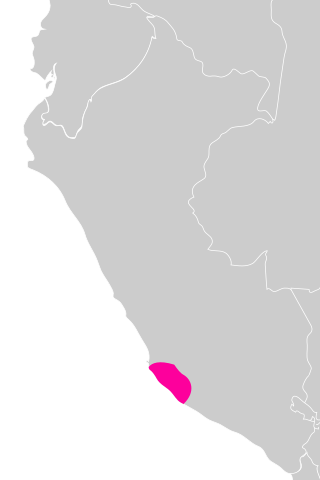
The Nazca culture was the archaeological culture that flourished from c. 100 BC to 800 AD beside the arid, southern coast of Peru in the river valleys of the Rio Grande de Nazca drainage and the Ica Valley. Strongly influenced by the preceding Paracas culture, which was known for extremely complex textiles, the Nazca produced an array of crafts and technologies such as ceramics, textiles, and geoglyphs.
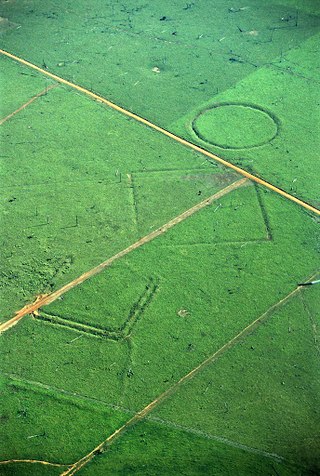
A geoglyph is a large design or motif produced on the ground by durable elements of the landscape, such as stones, stone fragments, gravel, or earth. A positive geoglyph is formed by the arrangement and alignment of materials on the ground in a manner akin to petroforms, while a negative geoglyph is formed by removing part of the natural ground surface to create differently coloured or textured ground in a manner akin to petroglyphs.

Lubyanka is a station on the Sokolnicheskaya Line of the Moscow Metro, located under Lubyanka Square. The facility, originally called Dzerzhinskaya station, opened in 1935 as part of the first stage of the metro.

The Paracas culture was an Andean society existing between approximately 800 BCE and 100 BCE, with an extensive knowledge of irrigation and water management and that made significant contributions in the textile arts. It was located in what today is the Ica Region of Peru. Most information about the lives of the Paracas people comes from excavations at the large seaside Paracas site on the Paracas Peninsula, first formally investigated in the 1920s by Peruvian archaeologist Julio Tello.

In archaeology, earthworks are artificial changes in land level, typically made from piles of artificially placed or sculpted rocks and soil. Earthworks can themselves be archaeological features, or they can show features beneath the surface.

The Tall Zira'a is an archaeological tell in Jordan. Surveys and geophysical investigations showed the site's great potential for excavations.

Cerro Sechín is an archaeological site in Casma Province of Ancash Region in northern Peru. Dating to 1600 BC, the site was discovered by Peruvian archaeologists Julio C. Tello and Toribio Mejía Xesspe on July 1, 1937. Tello believed it was the capital of an entire culture, now known as the Casma/Sechin culture or Sechin complex. Notable features include megalithic architecture with carved figures in bas-relief, which graphically dramatize human sacrifices. Cerro Sechín is situated within the Sechin Alto Complex, as are Sechin Bajo, and Taukachi-Konkan. There is a small on-site museum. The slabs at Cerro Sechin may represent the central Andes' oldest known monumental sculpture.
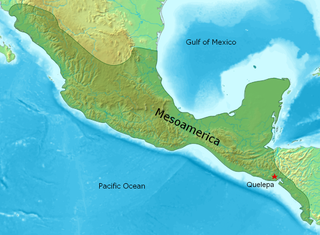
Quelepa is an important archaeological site located in eastern El Salvador. Generally considered to have been settled by the Lenca people, the site was founded around 400 BC in the Late Preclassic period. The inhabitants constructed a platform from plaster and pumice and rebuilt it a number of times. Artefacts recovered during the excavations of the site indicate that the local population depended upon subsistence agriculture, these artefacts included metates and comales. The site belonged to the Mesoamerican cultural region. Quelepa means "stone jaguar" in the Lenca language, probably in reference to the large Jaguar Altar found at the site.
Tell Shemshara is an archaeological site located along the Little Zab in Sulaymaniyah Governorate, northeastern Iraq. The site was inundated by Lake Dukan until recently.
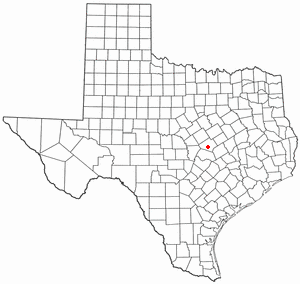
The Buttermilk Creek complex is the remains of a paleolithic settlement along the shores of Buttermilk Creek in present-day Salado, Texas, dated to approximately 15,500 years old. If confirmed, the site represents evidence of human settlement in the Americas that pre-dates the Clovis culture.
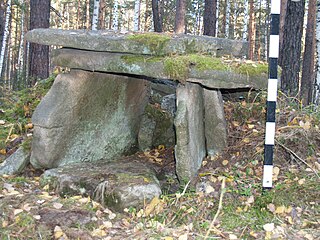
In recent years, many megaliths have been discovered in the Urals: dolmens, menhirs and a large megalithic cultic complex on Vera Island.
The Dyar site (9GE5) is an archaeological site in Greene County, Georgia, in the north central Piedmont physiographical region. The site covers an area of 2.5 hectares. It was inhabited almost continuously from 1100 to 1600 by a local variation of the Mississippian culture known as the South Appalachian Mississippian culture. Although submerged under Lake Oconee, the site is still important as one of the first explorations of a large Mississippian culture mound. The Dyar site is thought to have been one of the principal towns of the paramount chiefdom of Ocute, perhaps Cofaqui.

Blagaj Fortress or Old Town of Blagaj, locally known as Stjepan-grad (Стјепан-град), or Stipan-grad, in classical times Bona (Бона), is a town-fortress complex near the town of Blagaj, Bosnia and Herzegovina. The old Blagaj Fort was built on a high, inaccessible karst hill, at an elevation of 310 metres (1,020 ft) above sea level and 266 metres (873 ft) above the source of the river Buna. Blagaj Fort is 275 metres (902 ft) above sea level.
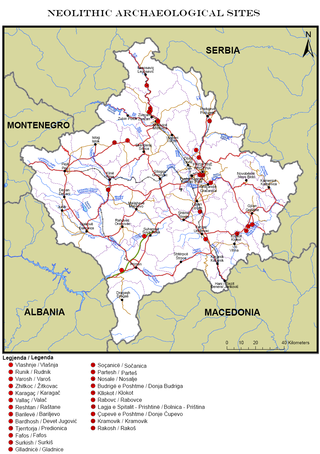
This is a description of Neolithic sites in Kosovo. The warm, humid climate of the Holocene which came soon after the ice melting of the last glacial period brought changes in nature which were reflected in humans, flora and fauna. This climatic stabilization influenced human life and activities; human society is characterized by changes in community organization and the establishment of permanent settlements in dry places, near riverbanks and on fertile plateaus.
Long Swamp Site is a 4-acre (16,000 m2) archaeological site in Cherokee County, Georgia, United States, on the north shore of the Etowah River near St Rt 372. The site consists of a South Appalachian Mississippian culture village with a palisade and a platform mound.
Chirand is an archaeological site in the Saran district of Bihar, India, situated on the northern bank of the Ganga River. It has a large pre-historic mound which is known for its continuous archaeological record from the Neolithic age to the reign of the Pal dynasty who ruled during the pre-medieval period. The excavations in Chirand have revealed stratified Neolithic, Chalcolithic, and Iron Age settlements, and transitions in human habitation patterns dating from 2500 BC to 30 AD.

Montegrande is an archaeological site in the Cajamarca department of Jaén province in Jaén District, Peru, a spiral temple or enclosure built c. 3000 BCE, by a culture that overlapped the current border with Ecuador. At 5000 years old, the site is as old as Caral.

















